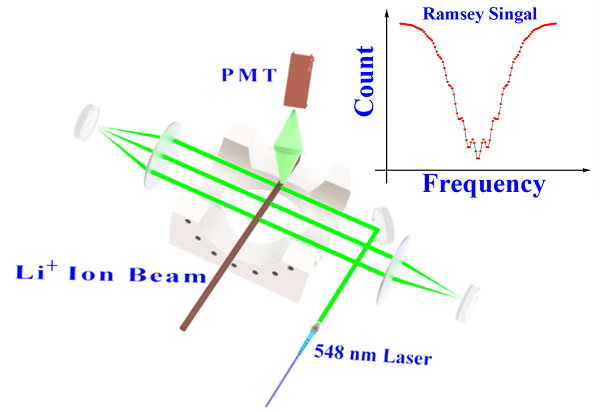Recently, the experimental team led by Gao Kelin and Guan Hua, the theoretical team led by Shi Tingyun, researchers from the Innovation Academy for Precision Measurement Science and Technology (APM), and Professor Yan Zongchao from the University of New Brunswick, professor G. W. F. Drake from the University of Windsor, Canada, Zhong Zhenxiang, a professor from Hainan University, and Qi Xiaoqiu, a lecturer from Zhejiang Sci-Tech University, and other experimental teams have made important progress in the study of the precise spectroscopy of lithium-ion in the Electron-less atomic systems, improving the measurement accuracy of the hyperfine structure splitting of the 23S and 23P states of 6Li+ ions to the level of 10 kHz, and accurately determining the electromagnetic distribution radius (Zemach radius) of the 6Li atomic nucleus. This work based on atomic precision spectroscopy is independent of atomic nuclear models, providing important evidence for revealing the structure of lithium nuclei, especially the peculiar properties of 6Li nuclei, and testing related nuclear structure models. This work will further promote the experimental and theoretical research on the precise spectroscopy of Li+ ions, and will also promote the development of nuclear structure theory and experiment in the system of few nucleons. The relevant research was published in the authoritative physics journal Physical Review Letters.

The experimental and theoretical research on the precision spectroscopy of Electron-less atomic systems(such as hydrogen, helium atoms, and hydrogen-like and helium-like ions) plays an important role in testing bound state QED theory, determining fine structure constants, obtaining atomic nuclear structure information, and exploring new physics beyond the standard model. It is one of the key directions of precision measurement physics in the world.
The experimental team led by Gao Kelin and Guan Hua, and the theoretical team led by Shi Tingyun, researchers from APM, have been collaborating on the study of precision spectroscopy of helium-like lithium ions for more than ten years. Based on the electron collision ionization scheme, the research team has developed a metastable Li+ ion beam source device, whose performance indicators (beam intensity, divergence angle, stability, etc.) have reached or exceeded the highest level of similar devices internationally. Using the ion beam generated by the device, the team accurately determined the fine structure and hyperfine structure splitting of the 23S1 and 23PJ energy levels of 7Li+ ions using saturation fluorescence spectroscopy, with an uncertainty of less than 100 kHz, an order of magnitude improvement over the previous international best result (Phys. Rev. A 102, 030801(R) (2020)). At the same time, combining experiment and theory, the Zemach radius of the 7Li atomic nucleus was accurately determined (Phys. Rev. Lett. 125, 183002 (2020)).

Lithium-ion Ramsey spectrum measurement diagram
In saturation fluorescence spectroscopy, the main limitation is the transit time broadening of spectral lines, resulting in a Ramsey dip linewidth of 50 MHz, which is much larger than the natural linewidth (3.7 MHz) of the spectral line. Therefore, the measurement results have large statistical uncertainties. To further improve the measurement accuracy, in this work, the research team used three-standing wave field optical Ramsey technology to eliminate the transit time broadening of spectral lines, obtaining Ramsey interference fringes with a linewidth of about 5 MHz and a statistical uncertainty reduced to the kHz level. By suppressing various systematic errors including quantum interference effects, first-order Doppler effects, second-order Doppler effects, Zeeman effects, and laser power, an accuracy of 10 kHz was achieved for the determination of the fine and hyperfine structure splitting of the 23S1 and 23PJ energy levels of 6Li+ ions. The measurement accuracy of this hyperfine structure splitting is 5-50 times higher than previous results. In theory, the research team calculated for the first time the hyperfine splitting of the 23S and 23P states of 6Li+ and 7Li+ ions including high-order quantum electrodynamics (QED) effects. With complete mα6-order relativistic and radiation corrections, the theoretical accuracy is improved compared to previous results, and there is good degree of compliance between theory and experiment. By comparing the theoretical calculations and experimental measurements of 6Li+ and 7Li+ ions, the Zemach radii of the nuclei of 6Li and 7Li were determined to be 2.44(2) fm and 3.38(3) fm, respectively, confirming that the nuclear Zemach radius of 7Li is 40% larger than that of 6Li. It was also found that there is a significant difference between the Zemach radius determined by the hyperfine splitting of the 23S state of 6Li+ and the value obtained from nuclear physics methods (3.71(16) fm), indicating that the nuclear structure of 6Li may be anomalous. This result will further promote the development of more related theoretical and experimental research.
The latest research results were recently published in Physical Review Letters. Postdoctoral Sun Wei and Associate Researcher Zhang Peipei at APM are co-first authors of the article, and researchers Guan Hua and Gao Kelin are co-corresponding authors.
This research was supported by grants from the National Natural Science Foundation of China, the Strategic Priority Research Program of the Chinese Academy of Sciences, the Chinese Academy of Sciences Young Innovators Promotion Association, and the China Academy of Sciences Stable Support for Basic Research Field Youth Team Plan.
Full text link:https://journals.aps.org/prl/abstract/10.1103/PhysRevLett.131.103002
